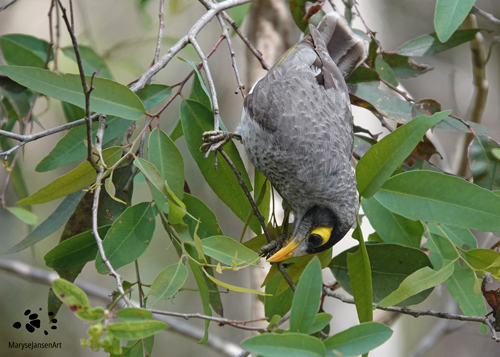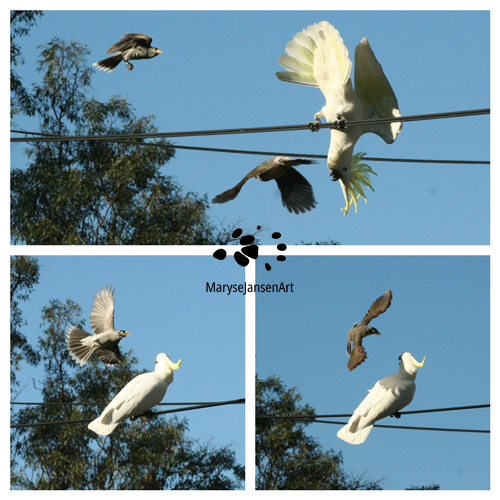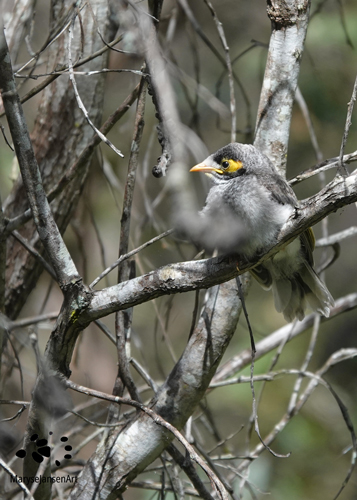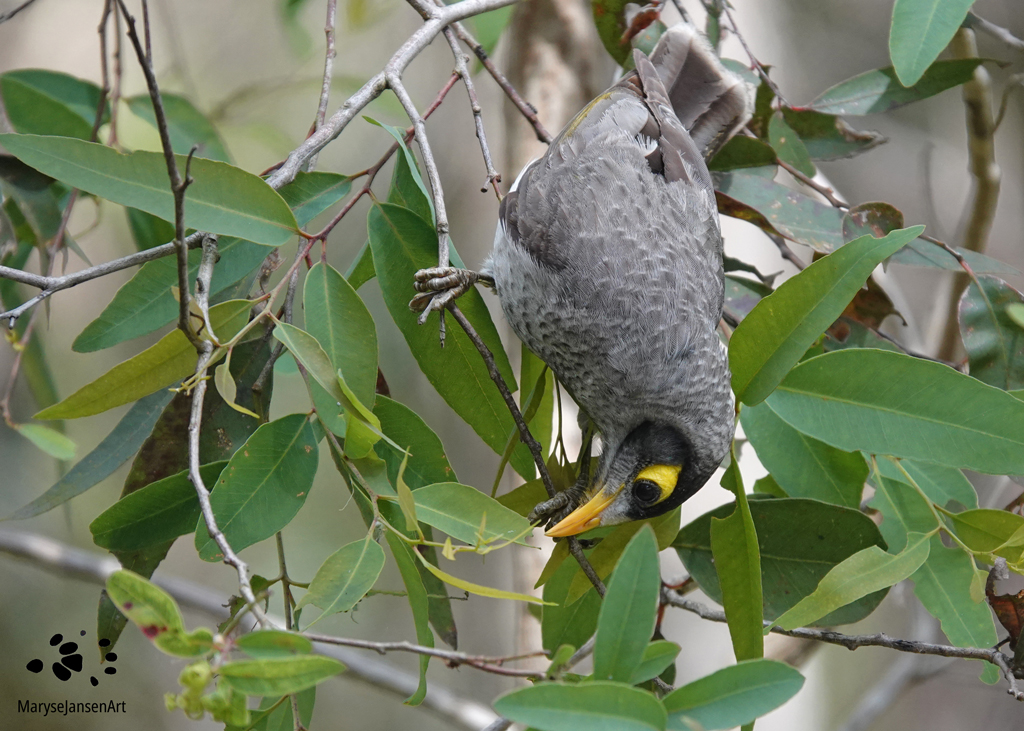Bird Photography with marysejansenart
Highly social bird defends its mob passionately

‘These birds can make such a racket’, I think, when I recognize the sound of the Noisy Miners. It’s worth checking it out though, because you never know what’s going on. An occasional piercing call breaks through their normal chatter. A group of them is hanging out in the leafless branches of some bushes, a number of them hopping around frantically while others don’t seem so worked up. I spot one individual that is leisurely picking ants of the branches and leaves of the next bush. It’s often hanging upside down in the process of getting to these delicacies. Another one is just staying put, only moving to preen its feathers.
I peer through my camera while I start filming. The noise intensifies. The preening bird, which looks like a youngster, is more alert now. Suddenly, one of the adult birds appears right next to the young bird upon which it opens its beak wide and now I see where the piercing call comes from! It is the sound the young bird makes as it receives food from the older bird! How wonderful, to be filming this moment!

Noisy Miners attack other birds to defend their territory
Noisy Miners are one of the roughly 100 species of native honeyeaters in Australia. Apart from nectar, this bird also feeds on insects and fruits. You will find them in woodlands and open forests along the east coast and also in South Australia and Tasmania. They are also very common birds in the suburbs, which I experience on a daily basis when they visit my garden.
What I also experience is their feisty nature! Noisy Miners are territorial birds and with their family group they will defend their patch aggressively. It might make sense that they chase other honeyeaters away as these could be competitors for food, but they are pretty much intolerant of anything that looks like a bird! And while it may be easy to overpower smaller birds, they are not easily put off by the size of big birds either!
They are not even remotely impressed by the large Sulphur-crested Cockatoo that is visiting my garden. They will simply not leave it alone, swooping it continuously until it finally gives up and leaves!

Of course, large birds of prey may form a threat to them or particularly, their young. Again, their tactic is to attack. The miners will form coalitions, where they swoop and harass their target in a group, to discourage it from its eyed meal. Meanwhile, they vocalise harsh alarm calls. I have witnessed this strategy to be quite successful. They also use it on other predators, like Lace Monitors.
Noisy Miner behaves like a bully but is not a pest
The Noisy Miners really are the bullies of the neighbourhood. No wonder that some people refer to them as a pest. But that is a misunderstanding. It is the Common Myna, also known as Indian Myna, that is the pest species. These birds originate in Asia and have been introduced to Australia in the 1860’s. They have become widely established along the east coast and beyond and have been declared one of the world’s most invasive species, posing a serious threat to Australian ecosystems.
They look a little bit like the Noisy Miners but both species are really quite easy to tell apart when you know what to look for.
The Common Myna is not a honeyeater but belongs to the starling family. Like the Noisy Miner, it has a yellow beak and legs, and bare yellow skin around the eye. But it is much darker in colour, with a black head and a dark brown body. The Noisy Miner is mostly grey and has a white forehead with a black crown. The wings have an olive-green patch and the bird has white tips on its tail.
Although Noisy Miners are not a pest, they can really dominate certain places. Their preferred habitat is open woodlands. These are places with tall trees and grasses but no dense shrubbery in the middle layer. In such a location there is very little protection for small birds and thus it is easy for the Miners to keep control over the area. Can you see what you can do in your garden to create a space of greater biodiversity? Plant lots of dense shrubs that provide food and shelter for small birds and fill up the empty layer between the grass and the tree canopies!
Noisy Miners social structures and communication
Noisy Miners are very social birds. We’ve already seen how organised they are in defending their territory. The birds have a range of calls and vocalisations that help them communicate with each other in these and other situations. They have a song they sing at dawn and dusk, they have a specific call that they use to stay in contact during foraging, there are mating display calls, the begging calls from the juveniles and alarm calls.
It is quite impressive that they have different alarm calls for different situations. The sound they make when they see an airborne predator, or another large bird, consists of high-pitched whistles. But when there is another intruder, predator or human being entering their territory, they produce low, harsh calls that vary in intensity. They also make clicking or snapping sounds with their beaks, which usually mean a warning to an intruder or predator.

The Noisy Miners breed in colonies that can vary from small to large numbers in the hundreds. The nest is built in prickly or leafy vegetation by the female alone and she is also responsible for incubating the clutch of 2-4 eggs. When the eggs hatch 4 weeks later, the males chip in and begin to help feed the young birds.
Other males in the group also tend to help with the feeding of the youngsters, especially when they begin to leave the nest. The young miners usually can’t even fly properly when they start venturing out. They can only fly downwards and scramble up! This means you may often see them on or low to the ground, looking quite helpless. But refrain from ‘rescuing’ them, keep your distance, and you will find that they are well looked after by their mob until they are ready to fly. This may take up to a few weeks!
It is pretty clear that the juvenile I mentioned at the start of this post is in that stage. It hops around a bit awkwardly on the branches but has no inclination to take flight. The adult birds are looking after it and bringing it food. Watch the video below of the latest episode of ‘Come for a walk in the Australian Bush’ and observe the scene yourself!
If you are interested in purchasing the featured image ‘Noisy Miner’ or would like to see what it looks like on the various products, please head to my shop.


